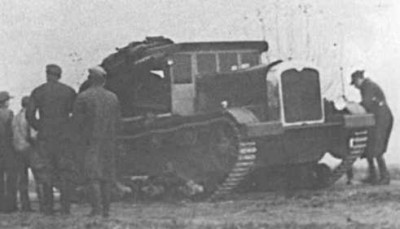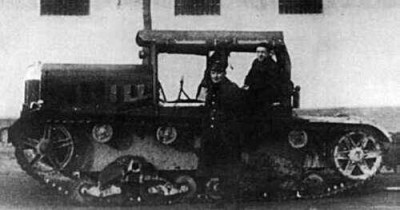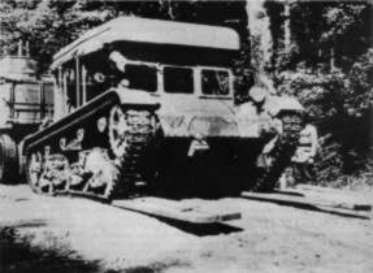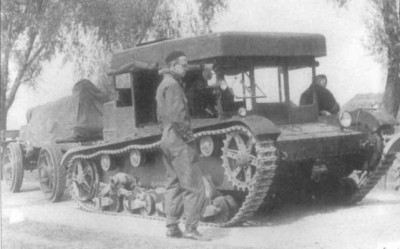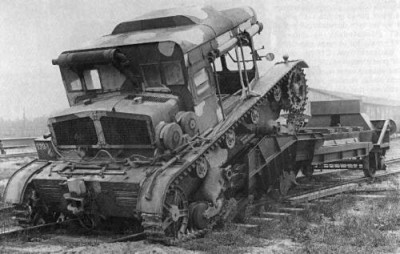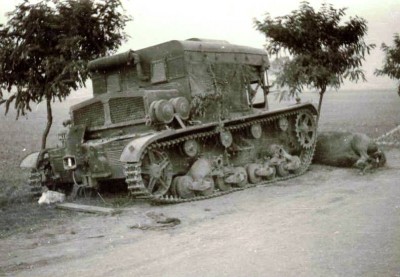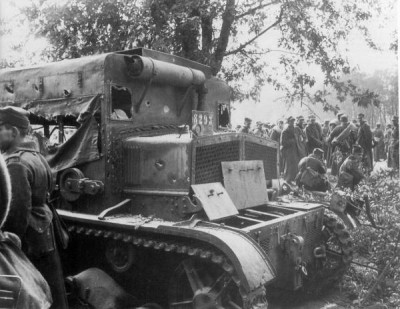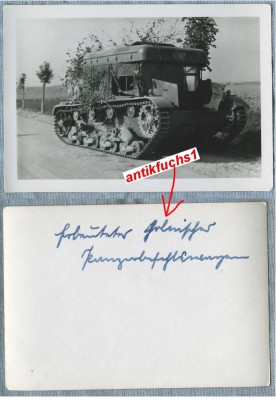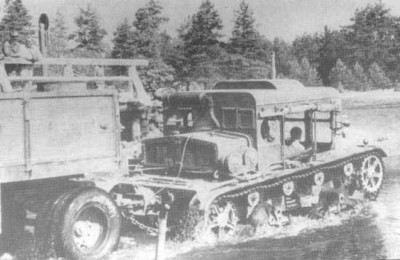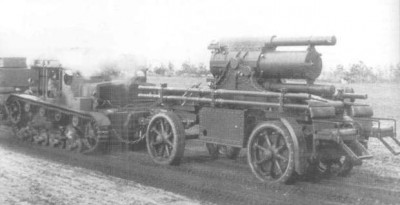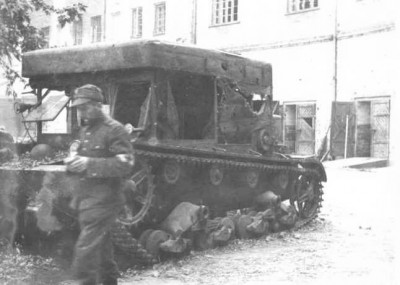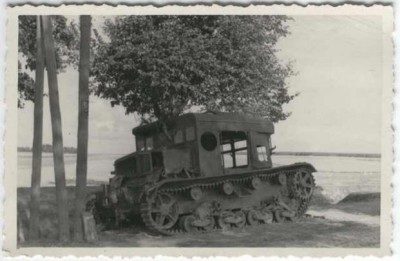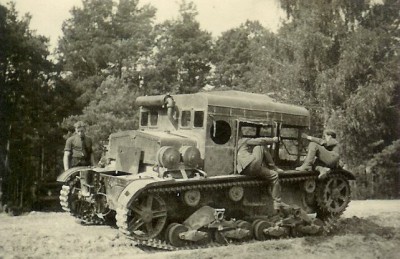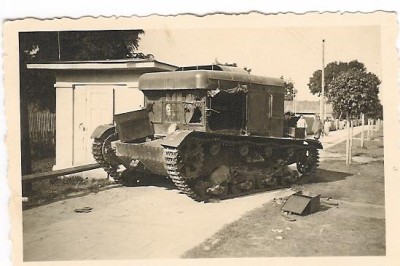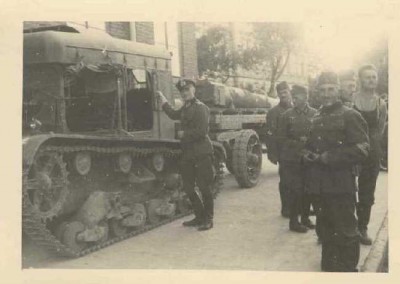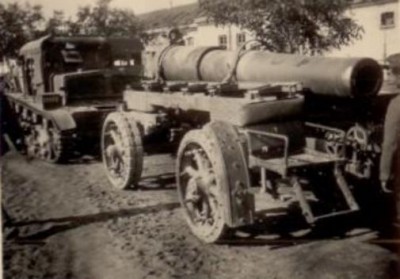In 5/1931, the Polish army representative, who came to agree on a contract to purchase 6 ton Vickers tanks and their licensed production rights was also presented. project of an artillery tractor Vickers Medium Gun Tractor, which was built on the chassis of this tank. However, they were not particularly interested in the machine and decided to enter their own development of a similar artillery tractor.
After the delivery of the first pieces of English Vickers and the beginning of the development of the Polish tank 7TP, the development of its own artillery tractor was started, the platform of which was to be from 7TP.
However, development continued slowly and two prototypes were not built until 1933. One marked as C6P had drive wheels at the rear, the other marked as C6T had front drive wheels.
In 2.-3./1934 intensive prototype tests were performed. After the tests, the C6T type was converted to the standard C6P (also referred to as C6P/II, later rebuilt and renamed to C7T/II). The original C6P was converted to C7T/I. This machine bore the registration number 8393 and the name "FELEK" given to it by the crew. Later, a third prototype C7T/III was created.
On May 12, 1934, the C7T was approved for series production. The tractors were to be used both for towing parts of large calibers, as well as for engineering units and in tank units (towing of damaged tanks).
The production of the first series was to take place at the F1 PLInz.URSUS plant in Warsaw. In the years 1934/35, the production of tractors was financially covered, but the factory at that time was not capable of simultaneous production of tanks and tractors. Preference was given to the production of tractors. Later in 1937-38, the factory was able to produce tractors and tanks simultaneously on two lines.
Production of C7P in Ursus in 1933-39:
1933- 2 prototypes assembled mainly from English supplies of parts
1934- 1 prototype + rebuilding of 2 prototypes
1934-36 - 73 serial machines
1937- 46 pieces
1938- ??? isolated machines
1939- min.29 pieces (13 pcs for tank units (?), 16 pcs with plows for the Ministry of Communications (?))
Planned: 1939/40-36 pcs 1940/41-36 pcs
In total, about 151 pieces of C7P (?) Were produced.
The main customers of the tractors were artillery units. In the years 1934-37, artillery units were supplied with min. 108 tractors.
Before World War II, Polish forces had only one heavy artillery regiment (1st Regiment in Gorza Kalwaria near Warsaw). The unit was armed with Czechoslovak masters vz.1932 caliber 220mm (made in Skoda Pilsen). In 1932, 12 pieces were purchased and in 1936 another 15 pieces of this weapon (at the same time a license for the production of ammunition was purchased). The Poles created three divisions of heavy artillery. Each had three batteries of two mortars. Each battery had 11 tractors (6 pieces for the transport of mortars, 4 pieces for the transport of accessories, ammunition and other material, 1 piece was a spare). The whole section was to have 33 tractors, the whole regiment 99 pieces. Later, tests were performed with cannons of other calibers, when there was subsequently a requirement to equip tractors with more powerful engines.
The second users of tractors were tank units.
As of July 15, 1939, they had 18 C7Ts in condition. 7 tractors were in Modlina, 5 in the 2nd Battalion in Žuravica, 4 in the 3rd Battalion in Warsaw, 2 in Brest. Later, just before the war, he received the 12th Battalion with tanks Renault R-35 4 pcs C7T[/i ]. A special trailer was developed for the transport of tanks 7TP, which was to be towed by a C7P tractor. Towing tests were successful and 7 trailers were ordered, which were delivered in the summer of 1939, and which were later actually used in the evacuation of 2nd Battalion tanks. Records of another order for 26 trailers have been preserved, but there is no information on their production.
In the years 1939/40, a total of 32 tractors were to be delivered for tank units (it is possible that some pieces were delivered before the evacuation of the factory, for example, for tank companies equipped with English Vickers).
Another user was to be the Ministry of Communications, which was to create special units to move along the railway tracks on special trolleys powered by the tractors themselves and to serve to remove damaged train sets during the war (after an air or other train attack). Structurally, it was a project similar to the one developed for the French Renault R 35 and Polish TK-3/[ url=/topic/view/8695] TKS[/url], which were able to move along the railway tracks in this way. The railway bogie for the 7 TP/C7P was designed by M. Becker and was completed in 1936. Tests of the prototype were successful. When towing wagons weighing up to 60 tons, the maximum speed of up to 60 km/h was achieved. 10 pieces of this chassis were ordered, but information about their production is missing.
It was planned to equip the units with 52 tractors by 1940. In total, however, the Ministry of Communications had until August 30, 1939 to receive 16 tractors with plows.
The individual machines were to receive engineering (planned two series just before the invasion of Poland - but in reality only a few pieces were produced) and other units. At the time of the outbreak of war, some machines were unassigned in warehouses.
Most of the machines were destroyed during combat operations, but some were used after the end of the fighting to remove destroyed combat equipment by German troops. It is also known to use machines with mounted snow plows to remove snow in the winter of 1939/40.
weight 8.5t
crew of 6-7 people
length 4600 mm
width 2400 mm
height 2400 mm
engine part Saurer CBLDb (PZInz.235) (115k/1800rpm)
max. speed 25 km/h
drive about 150 km
fuel supply 160 l
fuel consumption 96-120 l/100km
obstacles:
climb - 36 °, ditch - 180 cm, ford - 100 cm
tensile strength 5 tons
Janusz Magnuski - Militaria special Czolg lekki 7TP Vol 1. No.5, ISSN: 1231-692X
C6T
C6T
After the delivery of the first pieces of English Vickers and the beginning of the development of the Polish tank 7TP, the development of its own artillery tractor was started, the platform of which was to be from 7TP.
However, development continued slowly and two prototypes were not built until 1933. One marked as C6P had drive wheels at the rear, the other marked as C6T had front drive wheels.
In 2.-3./1934 intensive prototype tests were performed. After the tests, the C6T type was converted to the standard C6P (also referred to as C6P/II, later rebuilt and renamed to C7T/II). The original C6P was converted to C7T/I. This machine bore the registration number 8393 and the name "FELEK" given to it by the crew. Later, a third prototype C7T/III was created.
On May 12, 1934, the C7T was approved for series production. The tractors were to be used both for towing parts of large calibers, as well as for engineering units and in tank units (towing of damaged tanks).
The production of the first series was to take place at the F1 PLInz.URSUS plant in Warsaw. In the years 1934/35, the production of tractors was financially covered, but the factory at that time was not capable of simultaneous production of tanks and tractors. Preference was given to the production of tractors. Later in 1937-38, the factory was able to produce tractors and tanks simultaneously on two lines.
Production of C7P in Ursus in 1933-39:
1933- 2 prototypes assembled mainly from English supplies of parts
1934- 1 prototype + rebuilding of 2 prototypes
1934-36 - 73 serial machines
1937- 46 pieces
1938- ??? isolated machines
1939- min.29 pieces (13 pcs for tank units (?), 16 pcs with plows for the Ministry of Communications (?))
Planned: 1939/40-36 pcs 1940/41-36 pcs
In total, about 151 pieces of C7P (?) Were produced.
The main customers of the tractors were artillery units. In the years 1934-37, artillery units were supplied with min. 108 tractors.
Before World War II, Polish forces had only one heavy artillery regiment (1st Regiment in Gorza Kalwaria near Warsaw). The unit was armed with Czechoslovak masters vz.1932 caliber 220mm (made in Skoda Pilsen). In 1932, 12 pieces were purchased and in 1936 another 15 pieces of this weapon (at the same time a license for the production of ammunition was purchased). The Poles created three divisions of heavy artillery. Each had three batteries of two mortars. Each battery had 11 tractors (6 pieces for the transport of mortars, 4 pieces for the transport of accessories, ammunition and other material, 1 piece was a spare). The whole section was to have 33 tractors, the whole regiment 99 pieces. Later, tests were performed with cannons of other calibers, when there was subsequently a requirement to equip tractors with more powerful engines.
The second users of tractors were tank units.
As of July 15, 1939, they had 18 C7Ts in condition. 7 tractors were in Modlina, 5 in the 2nd Battalion in Žuravica, 4 in the 3rd Battalion in Warsaw, 2 in Brest. Later, just before the war, he received the 12th Battalion with tanks Renault R-35 4 pcs C7T[/i ]. A special trailer was developed for the transport of tanks 7TP, which was to be towed by a C7P tractor. Towing tests were successful and 7 trailers were ordered, which were delivered in the summer of 1939, and which were later actually used in the evacuation of 2nd Battalion tanks. Records of another order for 26 trailers have been preserved, but there is no information on their production.
In the years 1939/40, a total of 32 tractors were to be delivered for tank units (it is possible that some pieces were delivered before the evacuation of the factory, for example, for tank companies equipped with English Vickers).
Another user was to be the Ministry of Communications, which was to create special units to move along the railway tracks on special trolleys powered by the tractors themselves and to serve to remove damaged train sets during the war (after an air or other train attack). Structurally, it was a project similar to the one developed for the French Renault R 35 and Polish TK-3/[ url=/topic/view/8695] TKS[/url], which were able to move along the railway tracks in this way. The railway bogie for the 7 TP/C7P was designed by M. Becker and was completed in 1936. Tests of the prototype were successful. When towing wagons weighing up to 60 tons, the maximum speed of up to 60 km/h was achieved. 10 pieces of this chassis were ordered, but information about their production is missing.
It was planned to equip the units with 52 tractors by 1940. In total, however, the Ministry of Communications had until August 30, 1939 to receive 16 tractors with plows.
The individual machines were to receive engineering (planned two series just before the invasion of Poland - but in reality only a few pieces were produced) and other units. At the time of the outbreak of war, some machines were unassigned in warehouses.
Most of the machines were destroyed during combat operations, but some were used after the end of the fighting to remove destroyed combat equipment by German troops. It is also known to use machines with mounted snow plows to remove snow in the winter of 1939/40.
weight 8.5t
crew of 6-7 people
length 4600 mm
width 2400 mm
height 2400 mm
engine part Saurer CBLDb (PZInz.235) (115k/1800rpm)
max. speed 25 km/h
drive about 150 km
fuel supply 160 l
fuel consumption 96-120 l/100km
obstacles:
climb - 36 °, ditch - 180 cm, ford - 100 cm
tensile strength 5 tons
Janusz Magnuski - Militaria special Czolg lekki 7TP Vol 1. No.5, ISSN: 1231-692X
Ivo Pejčoch, Oldřich Pejs - Obrněná technika 5, Střední Evropa 1919-1945 Part I, ARES Publishing House, Prague 2004, ISBN 80-86158-32-2
Svatopluk Spurný - Polish tank 7TP, HaPM No.10/2001, ISSN: 1210-1427
| Period | - |
| Type | - |
| Camouflage | - |
| Country | - |
| Production No. | - |
| Poznávací značka / evidenční číslo | - |
| Tactical marking | - |
| Name | - |
| Unit | - |
| Date (DD.MM.RRRR) | DD.MM.RRRR |
| Author | - |
| Print size / 300 DPI | - |
| Published with authors permit | - |
| Author Website | - |
C6T
| Period | - |
| Type | - |
| Camouflage | - |
| Country | - |
| Production No. | - |
| Poznávací značka / evidenční číslo | - |
| Tactical marking | - |
| Name | - |
| Unit | - |
| Date (DD.MM.RRRR) | DD.MM.RRRR |
| Author | - |
| Print size / 300 DPI | - |
| Published with authors permit | - |
| Author Website | - |
C6T
